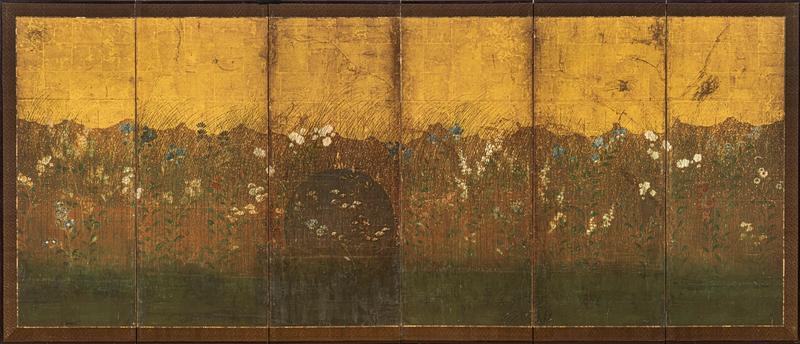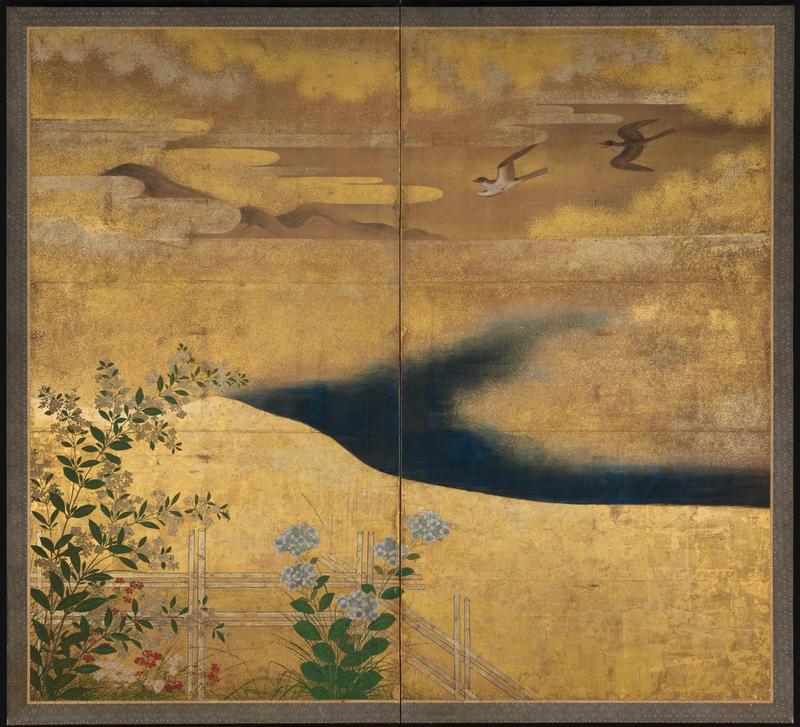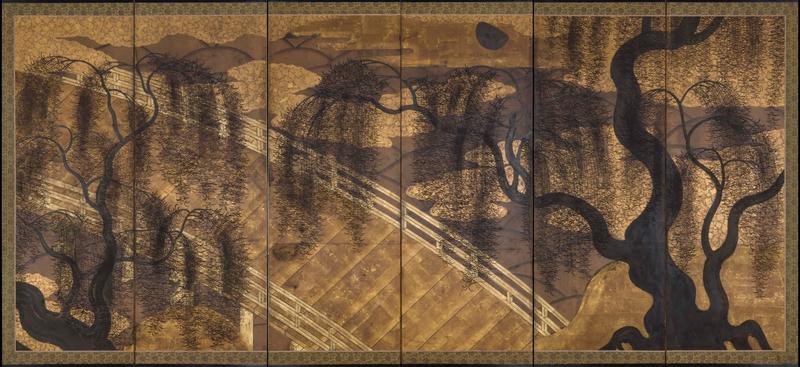A pair of six-fold screens with scattered fans
#7774/7806
Rimpa School
H. 172cm x W. 371cm (67¾” x 146¼”) each
A pair of six-fold screens with scattered fans, a waterwheel and jakago (rock-filled baskets) in flowing water beside a riverbank with a subtle golden mist in the distance. The motifs appearing on the fans include cranes, herons, geometric stripes, fringed pinks, maple and vines.
Ink, colour, silver, gold and silver leaf on paper.
Rimpa School, Japan, 17th century, Edo period.
Each screen bears a red seal of Ding form.
Provenance:
The previous owners are not known. However, an interesting part of the recent history of this pair of screens is that the left-hand screen was acquired in Kyoto in March 2021, as a single screen. In January 2021, the right-hand screen with exactly the same mounting silk and signs of age was found in Tokyo. It is clearly the pair to the first. It would appear that the two screens were separated at some point of their 400-year history and are now reunited.
This pair of screens are boldly and finely decorated in opulent gold and silver: the details of the river rendered in silver (now darkened due to oxidisation), the golden riverbank on the right-hand screen further decorated with cut gold and silver leaf, the jakago in golden moriage (raised design) and a thin mist in the distance rendered in fine gold dust.
The artist Tawaraya Sōtatsu (act. early 17th century), founder of the Rimpa school, was famous for his painted fans and many of them were later pasted onto screens in order to best preserve them, although there are also a number of fan-painted screens where fan-shaped outlines are applied directly on the screen and then filled with various motifs. The paintings seen on several of the fans in the present pair are typical of Sōtatsu's compositions and his distinctive style of painting, which would later become known as the Rimpa School.
Fans in flowing water (senmen nagashi) was a popular subject for Japanese screens and one of the favoured themes of the Rimpa School. Whilst the painting theme is classically Rimpa, this pair is also full of Rimpa aesthetics – the composition (the diagonal riverbank boldly occupying almost half of the right-hand screen), their trademark painting methods (tarashikomi [dripping-in] and mokkotsu [boneless] techniques used in rendering the plants on the fans), the highly stylised motifs of cranes, etc.
An array of open and partially-open decorated folding fans are scattered over the screens, as if being carried on a gentle wind and the turbulent river. Depicted on both screens are the rhythmic movement of the fans just entering the water, causing a small splash.
The Japanese have decorated paper folding fans with paintings since at least the twelfth century, and the first folding screens to feature scattered fans are believed to appear in the fifteenth century. It became popular around this time to paste or paint fans over a background of flowing water, a type of imagery that may have evolved from the medieval pastime of casting fans into a flowing river for a final appreciation of their beauty as they floated downstream when discarded at the end of summer.
A story that appears in the Ansai zuihitsu (Essays by Ansai), a collection of essays on miscellaneous subjects by the antiquarian Ise Sadatake (1717-1784), suggests one explanation for this fashion. According to the tale, an Ashikaga shogun of the Muromachi period was on his way to the Kyoto temple of Tenryūji when one of his vassals accidentally dropped his master's fan into the Ōi River from the bridge known as Togetsukyō. Taking their cue from the vassal, all the other members of the shogun's retinue followed suit and tossed their fans into the water. Screens painted with the fans-and-stream motif were often installed in shogunal residences.
As such, fans continue to serve not only a functional role for the Japanese, but also provide an intimate surface for painting and poetry and are the epitome of an elegant accessory.
Also notable are the waterwheel and the jakago (rock-filled baskets). They are usually associated with the Uji river, as seen in the screens of the famous theme, the Uji Bridge and willows; the combination of these motifs and fans is rare.
For an almost identical pair of screens, currently housed in the Guimet museum, Paris, (inventory no. MA 6264, 17th century), visit:
https://art.rmngp.fr/en/library/artworks/paravent-faisant-partie-d-une-paire-aux-eventails-flottants-sur-la-riviere_argent-metal
A six-fold screen depicting fans and jakago in water, attributed to Honami Kōetsu (1558-1637), is housed in the Tokyo National Museum (17th century, inventory no. A-1014, https://colbase.nich.go.jp/collection_items/tnm/A-10141?locale=en).
For screens depicting fans by the Rimpa School, see Murashige Yasushi and Kobayashi Tadashi eds., Rimpa Painting Vol. V, Assorted Themes, (Kyoto, 1992), p.19-76 (p.232-237), in particular:
a pair of six-fold screens with fans (including one with geometric stripe pattern) and jakago in water, by the circle of Sōtatsu, no.21.
For comparable Rimpa School motifs to those painted on the fans of this pair of screens, see Murashige Yasushi and Kobayashi Tadashi eds., Rimpa Painting Vol. V, Assorted Themes, (Kyoto, 1992), p.84 (cranes), p.120, 136 (waves), p147, 207 (diagonal hills).
Other 17th-century screens depicting fans on water can be found in a number of museums, including:
‘Women on a Bridge Tossing Fans into a River’ (early 17th century, Mary Griggs Burke Collection, accession no. 2015.300.110, the Metropolitan Museum of Art, New York): https://www.metmuseum.org/art/collection/search/53439; Miyeko Murase, Bridge of Dreams - The Mary Griggs Burke Collection of Japanese Art (2000, New York), p.348-351, no. 142.
‘Fans upon Waves’ (mid-17th century, H. O. Havemeyer Collection, accession no. 29.100.499, the Metropolitan Museum of Art, New York): https://www.metmuseum.org/art/collection/search/48922
Screens

A two-fold screen with the Uji River and its bridge

An eight-fold screen depicting flowers of the four seasons

A six-fold screen with a cherry tree

A six-fold paper screen with the Plains at Musashino

A two-fold screen with a river landscape

A six-fold screen with a covey of uzura and chicks

A six-fold screen with grape vines

A two-fold screen with chrysanthemums

A pair of six-fold paper screens with the Plains at Musashino

A pair of four-fold screens with kuri flowers

A two-fold screen with court ladies

Four fusuma by Nagasawa Rosetsu

A six-fold screen with autumn flowers and grasses

A six-fold paper screen with poem slips

A pair of six-fold screens with scattered fans

A paper screen with the Uji river and its bridge

A pair of six-fold screens with poem slips from the 17th century

A two-fold lacquer screen with a persimmon tree























